Roof Self-Check
When it comes to maintaining your roof, repairs or even replacement, cost is usually a big factor. To prevent costly issues from occurring in the first place, proper roof maintenance is a must, but there are many things that you can do to catch potential problems before disaster strikes. We’ve put together a list of potential issues you can look out for and check for yourself. As with all repairs, we recommend you call a licensed professional like the experts at Guardian Roofing.
If you’d like us to come out and inspect your roof for you, call us today at 877-926-9966, or schedule a free, no obligation evaluation online.
Select your Roof type for more information below:
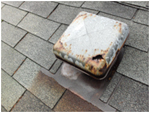 |
Broken/Damaged Vents – Over time vents can weather to the point of failure. They can also be damaged by flying debris or limbs from trees. These issues can cause major leaks, but can be identified and repaired if caught in time. |
 |
Damaged Plumbing Flashing – Any protrusion or penetration from the roof can leak. In order to prevent roof leaks flashings must be properly installed and in good working order. These flashings can fail due to age, erosion, or become dislodged by wind, rain, snow or moss and debris. |
 |
Damaged Flashing – Rusted, bent, or damaged flashing can lead to roof leaks. If your home has any of these conditions it is best to have a professional prescribe a solution for you. |
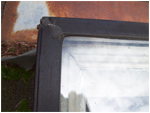 |
Skylight Failure – Skylights can allow water in where it meets the roof via poorly installed or damaged flashing. Or (As shown in the photo) the seal between the frame and glass can fail and leak. |
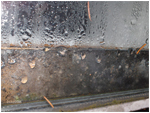 |
Skylight Condensation – Another sign of skylight failure is condensation in between the panes of glass. This means that the unit has lost its seal and is allowing heat and cold to transfer through the glass. |
 |
Wet Interior – Water stains on plywood or other wood substrate indicates a water intrusion. If you see this contact a professional immediately. |
 |
Moisture – For peer-and-beam homes, check the wood substrate that runs underneath the house. |
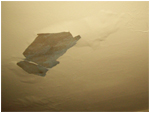 |
Wet Ceiling – Moisture on your ceiling is obviously a concern, but it can actually be a serious issue. This is because for water to actually show up in the ceiling it usually has to get past many layers of building materials such as Plywood, Insulation, Sheetrock, and Paint. If you notice a wet ceiling it should be addressed immediately. |
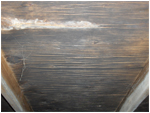 |
Discolored (Mildew or Mold) Plywood – The attic in our home should be designed to allow air to flow freely. This is to remove heat in the summer and moisture in the winter. It is important to remove the moisture that is created when warm interior air rises and meets cool air and causes condensation. Not removing this air can lead to mold, mildew, decay and poor insulation performance. |
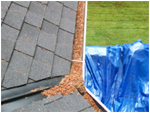 |
Clogged Gutters – Gutters that get filled with debris cause moisture to become trapped and even back up into the roof. This can lead to structural decay of the roof sheeting and over hangs. When filled with rain water or ice and snow the weight can cause gutters to pull away from the home or even crash down and damage the outside of your home. |
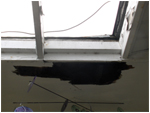 |
Rotted Framing – Water that is not controlled properly can cause costly damage to the wood beneath the roof. This can add a lot of cost to your project. Proper maintenance of your roof will go a long way to avoiding these issues. |
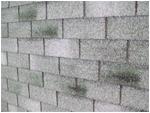 |
Granule Loss – The granules or “Grit” on top of an asphalt shingle has 2 jobs. One is to give the roof color and appeal. The other is to reflect UV rays away from the asphalt membrane. When a roof nears the end of its life it will start losing many granules because the asphalt will not hold them any longer. This issue can be compounded by aggressive pressure washing as well. If your roof shows granule loss it may need to be looked at to determine how much life is left and what options you may have. |
 |
Cracked Shingles – This is a serious issue. Especially if the cracks are horizontal as the picture shows. Asphalt shingles are held together with a mesh. This indicates that the mesh has given up and the material is cracking due to expansion and contraction. This is a serious sign of a need to replace |
 |
Curling Shingles – Once again, if the mesh that holds the shingle together begins to expire the shingles may begin to distort and curl. |
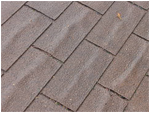 |
Buckling Shingles – Buckling shingles can also be a sign of the mesh expiring. However shingles can also be caused to distort and crack because the substrate that they were installed over cups, curls, or distorts. This can be the wood such as plywood, or the vapor barrier that is installed over the wood substrate and under the shingle such as tar or felt paper. |
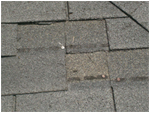 |
Missing Shingles – If your roof is not beyond it’s useful life, the only time you should lose any shingles off the roof is in a severe wind storm. (Over 70 m.p.h.) Other causes of shingle loss are: Improper fastening, Aggressive Pressure Washing, Moss and Debris lifting the shingle and breaking the bond. If you have missing shingles call a professional right away. |
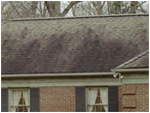 |
Algae – Many people think algae is dirt. It is actually a small plant that grown in shaded damp areas. Not only does it make the roof look ugly, but it traps moisture and can dislodge the granules on the roof. This can be controlled with proper maintenance, but if not dealt with it can shorten the life of the roof. |
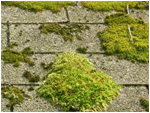 |
Moss – This is a roof nuisance. Moss too likes shaded moist areas. It is encouraged by debris such as tree needles and leaves. It can break the roofing seal and lead to blow off and leaks. It can also divert water into leak sensitive areas. When left to grow on the roof it also dislodges the granules and shortens the life of the roof. |
 |
Debris – Debris left on the roof and gutters encourages fungus growth. It also dams up the natural water channels in the roof and can cause leaks. In order to make the roof perform properly and last as long as possible maintenance is essential. |
 |
Cracked Shake – Shakes can crack from a number of reasons. Typically it is the quality of the individual shake. However it can also be from traffic on the roof or even harsh chemical treatment. Cracked shakes are a danger for leaks and blow off. The only thing keeping water out if the shake is cracked is the tar paper and that won’t hold for long. |
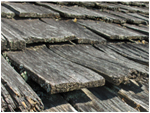 |
Curling Shake – It is not uncommon for even new shake to move around a little when the temperature changes or we go from a wet to dry season. But when sections of the roof begin to curl and stay deformed it is a sign that the roof is failing. |
 |
Cracked Shingles – Shakes that are blown away by wind or simply fall out do so because they have eroded to the point of weakness at the overlap of the upper course of material, or they have broken away from the fasteners. This can happen if the shake cracks and separates from the fastener, or it rots around the fastener. This can be caused by old age, debris and moss being left on the roof, or the use of harsh chemicals to “Clean” the roof. |
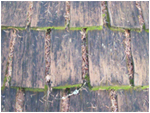 |
Moss and Debris – Not only does this make your roof look ugly, it also can cause leaks and shorten the life of your roof. Moss and debris trap water which can lead to rot. Especially when trapped under the shake. It can also divert water to leak sensitive areas and allow water to enter the home. Moss and debris can and should be managed with a comprehensive maintenance program. |
 |
Rotted Shake – Like any natural product that is exposed to weather, over time it erodes. If the shake roof is comprised of different wood qualities it is not uncommon for only the lesser quality wood to decay early. Some times this can be repaired. Aggressive pressure washing, harsh chemicals, and presence of moss and debris can accelerate roof decay. |
 |
Alligatoring – When the flexible asphalt compound ages beyond its useful life it loses its elasticity. This leads to surface cracking referred to as “Alligatoring”. These cracks indicate that the roof is nearing the end of its life. One way to prolong the life of an asphalt based flat roof is to apply a product compatible UV coating . This must be done well before the roof begins to get Alligator cracks. |
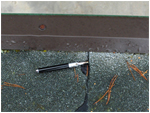 |
Roof Seam Fail – Most asphalt based flat roofs are built with layers of material that are lapped together. Common areas for leaks are the seams and joints. This is due to either improper installation, or roof age. These areas are vulnerable to separating because there are multiple sheets pulling because of expansion and contraction. Since the seam is where they connect it endures the most strain. Depending on the cause of separation and material type this may be repairable. |
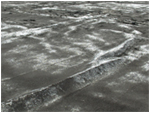 |
Buckle in Membrane – Asphalt flat roofs are constructed similarly to sloped roofs. They have a mesh reinforcement that is soaked with asphalt. When the roof wears out, the mesh begins to distort and buckle. This is a sign of an expired roof and is vulnerable to failure. |
 |
Membrane Pull Out – When the mesh reinforcement expires the roof many times will contract. This can cause the membrane to pull away from flashings. Especially around the perimeter of the roof. When this happens there is nothing to keep water from getting under the roof and typically leads to leaks and other problems. |
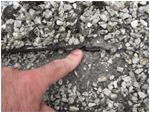 |
Crack in Roof – When the stress on the roof becomes too great it can crack through the entire membrane. This allows water to enter the home and leads to leaks. |
 |
Cracked Tile – Tile roofs are somewhat fragile. Cracks can be caused by foot traffic, branches falling and even expansion and contraction. This can typically be repaired, but getting an accurate style and color match can prove to be difficult. |
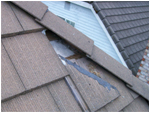 |
Missing Tile – Many tile roofs are not fastened. They are loose laid on the roof. This can lead to tiles becoming dislodged and falling out. Regular inspections and maintenance will help to avoid this from happening. |
 |
Tile Debris – Debris is a more serious problem with tile roofs than any other. This is because Tile roofs are not sealed and are designed to allow water to run under the tile. So when debris diverts water where it is not designed to go leaks can and probably will occur. It is critical to keep moss and debris off of your tile roof. |
 |
Moss – because most tile is made from concrete (Which is Porous) it is very susceptible to fungus growth. This is because the pores absorb moisture and nutrients to feed the moss and algae. Once it grows it can break down the concrete and divert water into leak sensitive areas. |
